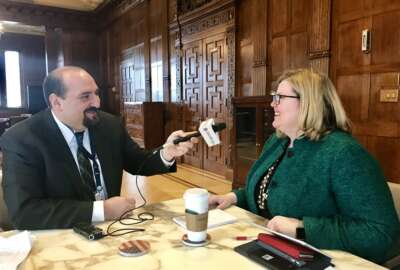 Exclusive
Exclusive  Exclusive
Exclusive At the 2018 ELC conference, GSA and the IRS were among the agencies highlighting how robotics and other emerging technologies can make federal acquisition better...
PHILADELPHIA — The Federal Acquisition Service at the General Services Administration spends $100 million a year on systems that are outdated, disliked by their users and arduous to use. There is something like 70 applications that interface with the contract writing system alone.
The IRS wants to replace systems that require tens of thousands of manual hours to process basic procurement actions like contractor determinations.
The debate over the use of Other Transaction Authority remains strong over whether it’s just another tool in the procurement toolbox, or has the Defense Department discovered the “Holy Grail” of contracting because Congress gave them production authority.
All of these examples really are just symptoms to the larger disease — the need to reimagine the entire job of a contracting officer. With the move to automation happening more quickly, contracting officers soon will finally achieve the business acumen and partnership role that has been long talked about.
The good news is the change is starting to happen. One of the major themes that emerged from the 2018 ImagineNation ELC conference sponsored by ACT-IAC was around the evolution hitting the federal acquisition process.
GSA Administrator Emily Murphy said reconceiving how a contracting officer works is one of her main goals for FAS as it modernizes its schedules program by reducing the number of overall of contracts, by moving toward an unpriced schedule and pushing competition down to the task order level.
“When I’ve talked to our 1102 community and when I talk to our vendor community, one of the questions I always ask is, ‘What value are we driving from setting ceiling prices?’” Murphy said after her speech at ELC. “When we are reimaging how the schedules work, if we incorporate things like the e-commerce platform, which deals with the very low dollar value purchases, and we focus on services being an unpriced contract where we actually focus on pricing at the task order level, that frees up our 1102s. They no longer are negotiating the same ceiling prices again and again. They are instead focusing on how to make sure task order competition is real, vigorous and it’s dynamic.”
Murphy said the combination of technology, such as robotics process automation and machine learning, and business process reengineering, contracting officers can spend more time on finding the right solutions based on data and business needs.
“Think about when we awarded OASIS, it required labor hour prices per category, but it really focused a lot more on the technical qualifications of the vendors,” she said. “This gives us the ability to focus on those technical qualifications, what makes each vendor successful, unique and what can they bring to the table as a solution, instead of focusing on that contract hour price. That contract hour price becomes relatively meaningless until you get to an actual scope of work. Then you have dynamic competition at the task order level and drive down prices with a real solution behind those prices.”
To get where Murphy wants to go, FAS needs better technology that runs its assorted contracting systems.
Alan Thomas, the FAS commissioner, said its internal systems such as E-Buy, GSA Advantage, the FSS 19 and many others that make up their core business systems are expensive to maintain and not customer friendly.
Thomas and David Shive, the GSA chief information officer, are co-leading an effort to modernize and consolidate systems. He said FAS will lean on GSA’s CIO application maintenance, enhancements and operations (CAMEO) re-compete. The agency held an industry day in early August and plans to issue a request for information and hold a reverse industry day.
“We have picked the capabilities we want to have like the ability to write, modify and manage contracts or to manage catalog information, instead of modernizing system by system,” Thomas said after his panel at ELC. “Within six months, we will have the requirements for our new contracting writing system out to industry, and by the back half of 2019, we expect to begin delivering new capabilities.”
Thomas emphasized that the business system modernization effort is a multi-year strategy and it integrates with other initiatives such as schedules consolidation to reach its full potential.
Like GSA, the IRS is facing antiquated systems as well as a shrinking workforce. The tax agency spends about $2.6 billion a year on 10,000 transactions.
Tim Shaughnessy, a senior program analyst at the IRS, said a new strategic framework for the agency includes the procurement process for the first time.
“We are recognized as partners who create and buy emerging technologies and do acquisition planning,” he said at ELC. “We spend a lot of time at the end of the fiscal year trying to secure dollars early enough to set up process to buy emerging technologies.”
Shaughnessy said for the staff of 300 procurement professionals to do that more effectively, the IRS is turning to robotics process automation to reduce the amount of time spent on basic transactions.
The IRS awarded its first contract for RPA at the end of September for a bot to do contractor responsibility determinations.
“We do about 10,000 of those actions a year and the RPA is our way of dipping our toe in the RPA water,” he said. “We think this will save contracting officers about 10,000-to-15,000 FTE hours a year.”
The bot will go to public facing websites such as SAM.gov or Dun & Bradstreet to analyze data on vendors to review overall contractor financial resources, integrity and business ethics and anything that that would not otherwise exclude a vendor from bidding.
“The bot gives us the ability to quickly look at the System for Award Management (SAM) and other systems and give the contracting officer a report back on a vendor’s status,” Shaughnessy said. “The contracting officer can analyze the data that the bot brings back and pivot off that in case they need to do more investigations. We also don’t have to wait until a proposal comes in or there is an apparent winner to do a contractor responsibility determination. The bot could bring back data on all the companies who proposed.”
Along with RPA, Shaughnessy said the IRS procurement shop also is testing out a new program under Parts 12 and 13 of the Federal Acquisition Regulation to pilot emerging technologies. The IRS doesn’t have OTA authority so this is the next best thing.
Under FAR Parts 12 and 13, agencies can use streamlined evaluation procedures as long as the awards are under $7 million and it’s not to deploy new systems, and only to test and pilot.
“We haven’t picked which programs we will use this for yet. We are socializing and working with stakeholders as well as partnering with the CIO’s organization,” he said. “One of the things we are trying to do is develop, along with the CIO, a capability for us to take a concept from a white paper to initial deployment.”
Shaughnessy said one possible option is with document imaging and data capture through optical character recognition. The IRS has as many as 27 different document imaging systems. Using this pilot program, it could consolidate and modernize the entire document imaging effort.
The IRS, GSA and other agencies are making it clear the status quo around acquisition isn’t working and working within the system to change is not only possible, but happening every day. This is why the aggressive move to OTAs is disturbing to so many because instead of fixing the procurement system, like GSA, the IRS and others are trying to do, agencies are looking for a way around it.
Copyright © 2025 Federal News Network. All rights reserved. This website is not intended for users located within the European Economic Area.
Jason Miller is executive editor of Federal News Network and directs news coverage on the people, policy and programs of the federal government.
Follow @jmillerWFED
 Exclusive
Exclusive  Exclusive
Exclusive 
